This page provides details about the different Kihon, or the basic elements of Kyokushin Karate. Included are Stances, Strikes & Blocks, Kicks and how to tie a Karate Belt.
Click on any image for video.
- Fudo dachi – Immobile stance
- Yoi daichi (Shizen tai) – Ready stance
- Musubi dachi – Formal attention stance
- Heiko dachi – Parallel stance
- Soto hachiji dachi – Outside figure 8 stance
- Uchi hachiji dachi – Inside figure 8 stance
- Sanchin dachi – Three battles stance, three point stance, hour glass stance, etc.
- Moro ashi dachi – One foot forward stance
- Kokutsu dachi – Back stance
- Neko ashi dachi – Cat foot stance
- Kake ashi dachi – Crossed leg stance
- Zenkutsu dachi – Front stance, forward stance, etc.
- Kiba dachi – Horse riding stance
- Shiko dachi – Sumo stance
- Tsuru ashi dachi – Crane stance
- Heisoku dachi – Closed foot or blocked foot stance
- Shizen tai (Yoi daichi) – Ready stance
- Seiken Chudan Zuki
- Seiken Jodan Zuki
- Uraken Gamen Uchi
- Uraken Sayu Uchi
- Uraken Hizo Uchi
- Uraken Mawashi Uchi
- Seiken Ago Uchi
- Shita Zuki
- Hiji Uchi
- Jodan Uke
- Chudan Soto Uke
- Chudan Uchi Uke
- Gedan Barai
- Chudan Uchiuke Gedan Barai
- Shuto Gamen Uchi
- Shuto Sakotsu Uchioroshi
- Shuto Sakotsu Uchikomi
- Shuto Uchi Uchi
- Shuto Hizo Uchi
- Mae Keage (Front rising kick)
- Uchi Mawashi (Outside Crescent Kick)
- Soto Mawashi (Inside Crescent Kick)
- Hiza Geri (Knee Kick)
- Kinteki Geri (front Kick)
- Mae Geri (Front Ball Kick)
- Yoko Keage (Side Rasing Kick)
- Kansetsu Geri (Side kick)
- Ushiro Geri (Back kick)
- Mawashi Geri (Roundhouse Kick)
Ido geiko (移動稽古) – training kihon techniques in movement. It is a form trained in order to improve coordination and dynamic memory movement . It involves moving the positions (dachi) using the basic strikes (tsuki) and kicks (geri) and blocks ( uke ) Theoretically, it must be a combination. Depending on the Sensei the set of techniques is dictated. People often choose a combination of their own experience.
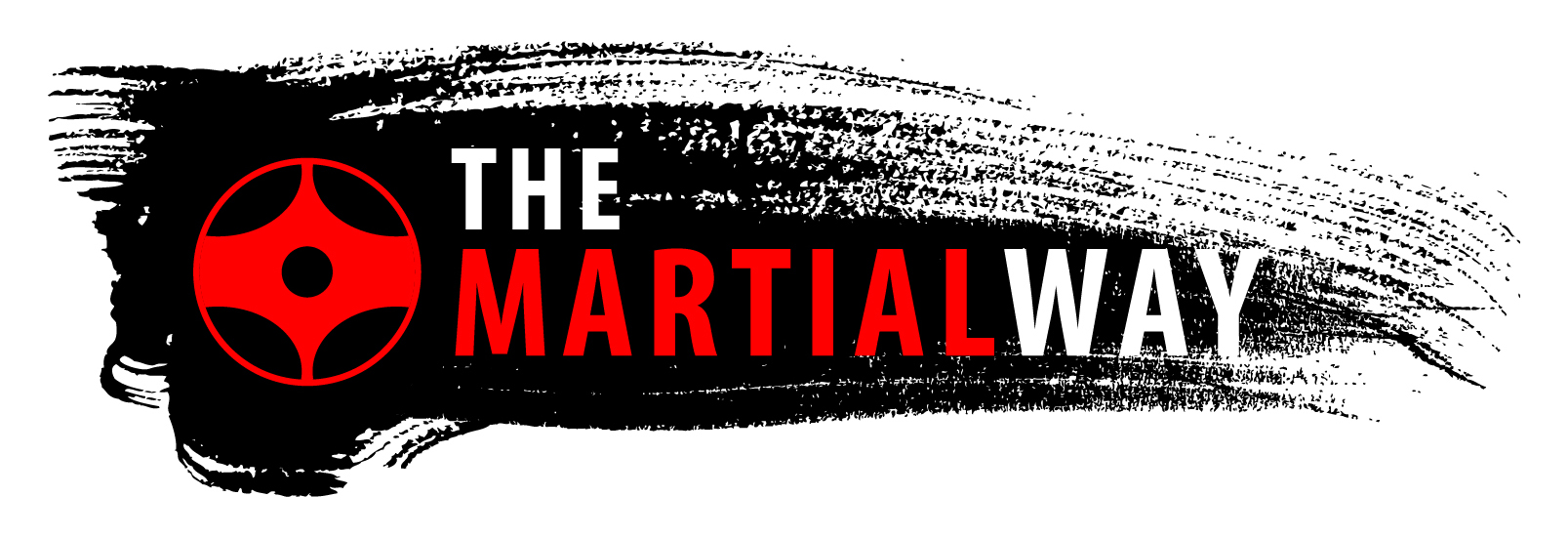
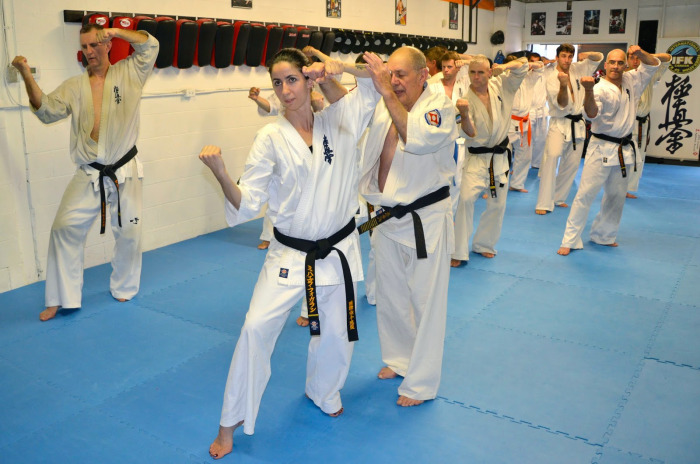
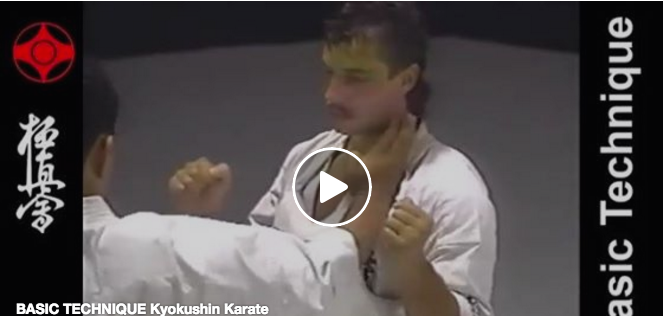
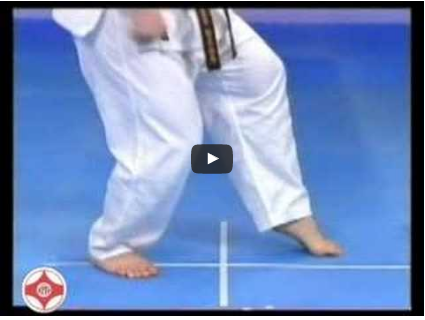

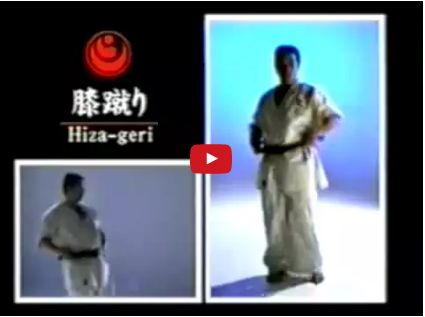
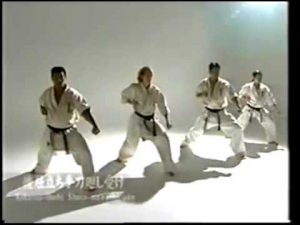

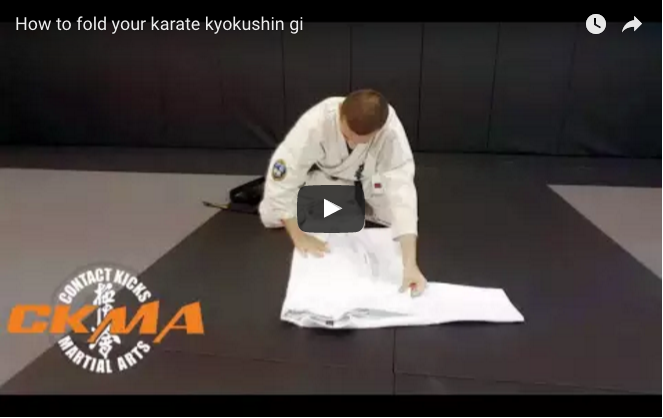
Comments 8
OSU!
Hello Again,
It’s Damian (IFK Ireland). After some time after receiving the info from you, some ideas came to my mind.
And I need to validate them or discard it. I want to test my understanding a bit.
So… zenkutsu dachi. Among many things, we have PROPER PUNCHING FORM.
Ok then. Since all thinking must start from kamae, here goes:
In kamae the torso is angled at 45 degres in order to expose less.
Let’s say we have a combo. In kamae we execute oi tsuki – gyaku tsuki.
If the oi tsuki is not a feint and it has power after execution, the torso will be at a 90 degrees in order to have the body behind it.
When we follow up with gyaku tsuki, at the end of this movement we end up with the hips squared facing forward.
And that is the split-second moment when FORCE IS APPLIED.
Even though the stance is higher and the back leg pushes through the ball of the foot is resembles zenkutsu dachi.
So…zenkutsu dachi is a training stance , that appears in real fighting for a split-second, so it is transitional.
And the moment it appears it is the same moment when we need to apply force. Therefore the power transfer principle.
And now the proper punch form principle seems clear.
And I think that is why we have it a lot in kata.
Muscles have slow-twitching and fast twiching fibers.
It would seem that because we always stand in zenkutsu dachi we train the slow-twitching fibers. ( actually yes but that is for retracting the body after it was extended in a technique) but is about fast twitching fibres , that is why we “snap” the movement.
Right…I know zenkutsu dachi has more secrets but I think this is the first idea to be learned.
If what I described above is true, it means every thing else will follow.
So…proper punching form. Have I got it or have I failed to understand?
I would really apreciate your feedback ( a very detailed one if possible 🙂
OSU!
Thank you so much, Scott. I am most grateful for the information provided. Solid gold.
Now I understand how long it would have taken to get that explained in the dojo.
It is a lot to digest but it is exactly what I need it. It will take a bit to let it sink in and practice until it becomes second nature.
At least I understand now.
Again much obliged.
OSU!
kind regards,
Damian Cosmin , IKKO
Author
You are very welcome, and thank you again for reading and taking the time to comment. Good luck in your training…. Osu!
Scott
#1 Hi, my name is Damian. I joined the Irish Kyokushin Karate Organization (branch of the IFK ) in september. I can only train 1 day a week at the dojo. I do spend 2 h daily training by my self. A dojo is a place of trainig and not of talking (to much that is). Maybe you could help with a bit of info.
Purpose of sanchin dachi and zenkutsu dachi.Not sure.
All ideas must start from jyu kumite.
A:/Sanchin dachi improves: primary reasons for training would be the hip snap efficiency, second thing coordination for applying force (heel, ankle, knee,hip,shoulder,elbow, wrist, seiken), and third developing a sense of rooting into the ground, a suction-like feeling.
True or false? what else is there? yes I know about leg training but that is something that I call secondary benefit.
B:/Zenkutsu dachi. In jyu kumite we can execute a combo statically (hip snap used a lot) and we can also hit while moving (like a step forward and jab whith no hip snap, sorry oi tsuki ).And this is where zenkutsu dachi training has meaning. But is it just that? what else? I noticed what for a beginner moving legs and coordinating hands it is a bit difficult.That is probably why we have ido geiko. But ….what else? other primary reason? why first zenkutsu and after kamae, and not straigth from guard stance? yes preparatory stages, but how exactly and WHY?
I know ist best to have an instructor explain this”live” but is not posible for me at the moment.I NEED to know, if I do not know I do not have peace of mind, I cannot put my heart in, and I am not giving up.
I have done some research on my own and it is very foggy and generic.
I need to know for sure.Not just the form but the function and the reason for training and of course how to be applied. In this case just the training reason for sanchin and zenkutsu.PLEASE
Thank you in advance
Damian Cosmin , IKKO
Author
Thank you for commenting Damian… I am with IFK Canada. Welcome to the organization! Osu! To answer your questions:
1) Sanchin – I wrote an article on this you can find here: http://the-martial-way.com/sanchin-three-battles-of-kyokushin-karate/
2) Zenkutsu-dachi – opens the doors for mastering all other stances as well as learning proper punching technique and power transfer, blocking, weight distribution, centring and upper and lower body connection for the performance of strong technique to name a few.
The purpose of a front stance includes showig direct power forward by stepping, or in a static position attempting to mimic the mass of a stepping punch by trading it for hip torque and rear leg thrust.
Breathing is an important factor, the breath must be kept low in the diaphragm so as not to raise the center of gravity by breathing too shallow or high in the chest, not to mention cheating ourselves of the full capacity of our lungs, but for now we’re focusing on our center.
We want to move from our center, we should strive to move our body around by our center and not by just the feet or leading with the chest.
Focusing on keeping your center and not raising up or moving with your chest. The importance of what is taught here is the basis for understanding other stances to come. How we make use of the center of gravity in a given stance is very important in controlling your movement as well as your opponents.
From a zenkutsu-dachi (front stance) we next have connection to the ground which dovetails nicely with upper and lower body connections. By having the heel planted firmly on the ground we create a solid connection between the floor and the target.
Using jodan uke (upper level block) works well in conjunction with zenkutsu-dachi when teaching this principle. Paying close attention not to make the common mistake of stepping back too far or shifting the weight backwards we also learn how to utilize centering and weight distribution, now putting to use some of the lesson we learned at the beginning.
In the case of a left block against a right attack the right leg would shoot back with the heel being planted firmly on the ground. Care should be taken here to “drop” into the stance rather than merely stepping backward. Stepping too much and sending the center of gravity back takes away from the forward projection of the stance, which is what front stance is about.
The planting of the rear foot/heel should be timed with the blocking arm making contact with the target to add support to the technique.
After learning these principles as applied to zenkutsu-dachi applying them to other stances or areas will be easier.
Punching is the next step and maybe the most important one in understanding the connection to the ground. Feeling the solid contact with a target and the reaction of the rear leg/heel into the ground along with the power of the rear leg thrust brings it all together. Education here comes from the use of targets and the actual feel of the transference of power into the target. Of course hip action is involved here and should be taught and stressed throughout.
The upper/lower body connection goes hand in hand with connection to the ground. We can have a perfect block and we can have our foot planted but that doesn’t ensure that it has the timing or the power to do the job and the same goes for our punch or strike. The upper body must work together with the lower to create the right sequence of events to maximize our efficiency.
If the upper and lower body are working together the initial step will be smaller (by not jumping into the step) and the landing and hip action will be working together with the arms to power them into the block. This is where the explanation of hanmi and hip movement are explained to highlight the coordination of these movements.
Learning proper use of this now will aid in more advanced use of hip rotations and hanmi later on in the intermediate to advanced stages.
When we step forward swiftly using a powerful oi-zuki, we have the bonus of mass behind us and we are moving our whole body forward into the target as an added extra. The support leg is driving into the ground (ground connection) as it drives all our mass forward into the target. We are utilizing what we have learned in the lessons above about breathing through our lower abdomen, keeping the center of gravity low and not raising the breathing into the chest, moving our center forward and not lunging chest first, proper timing of the technique with the target as well as keeping the rear heel on the floor.
Proper breathing, centering, balance and weight distribution, hip action, upper/lower body connection and connection to the ground all play an important role in powering a strong gyaku-zuki (reverse punch).
In conclusion the zenkutsu-dachi (front stance) in the most important stance. The ease in which it allows the above lessons to be taught and learned make it a valuable tool in setting up the student for more advanced techniques and smooth transitions.
Zenkutsu-dachi is a key that unlocks many doors, how deeply you enter is up to you.
Ossu! Great material! I Have a question. The material you upload, is it common for all “iko’s” or there are some technical differences among them?. I’m asking because currently I’m training by myself, I had to move from the city I used to train, and the city I am now doesn’t have any Kyokushin Karate (IKO1) dojos around. Thanks for the great work you have done uploading all these valuable material. Ossu!
Author
Osu! Thank you for reading Sebastian. To answer your question, they are all ver similar. I belong to the IFK, and there are subtle differences in a couple kata, but that’s about it. There can be additional things. For instance, in IFK, we have the syllabus, to help remember requirements. You can see what I mean here http://the-martial-way.com/organizing-your-kihon/
Good luck with your training, and please keep reading! OSU!
Nice